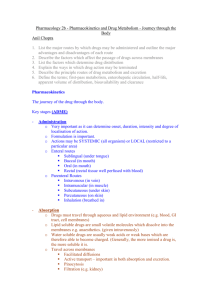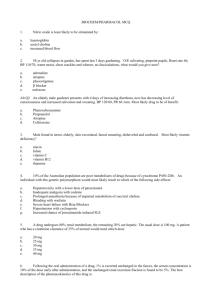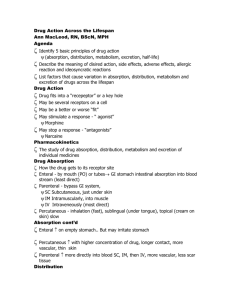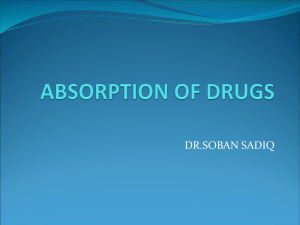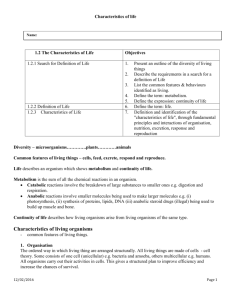06.(LEC 6) PHARMACOKINETICS
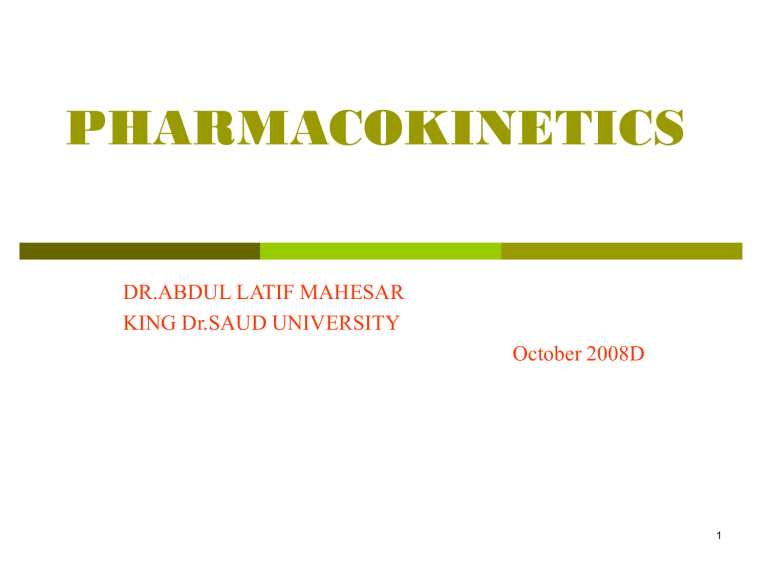
PHARMACOKINETICS
DR.ABDUL LATIF MAHESAR
KING Dr.SAUD UNIVERSITY
October 2008D
1
DRUG ABSORPTION
Is the passage of the drug through body barriers or cell membranes to reach its site of action
2
Mechanism of Drug Movements
Across Cell Membrane
Passive diffusion ( simple diffusion )
Active transport
Facilitated diffusion ( need carrier )
Pinocytosis (endocytosis)
3
Passive diffusion
Types: a) Aqueous Diffusion ( filtration through the pores) => water soluble and low molecular weight.
B) Lipid diffusion => lipid soluble and low molecular weight.
4
5
e.
f.
a.
b.
c.
d.
Characters
Commenest
Non selective
Require no energy
Depends on concentration gradient
Depends on lipid/water partition coefficient
Depends on PKa (of drug) and PH ( of the medium.
6
PKa ( is the dissociation or inization constant) is the PH at which half of the substance is ionized and half is unionized
PH is the ionization of the drug weak acids => best absorbed in stomach( because acid wont be ionized – lipid soluble
– best absorption.
Note: strong acids or bases are fully ionized (polar+water soluble)- can not cross cell membrane ,given IV infusion
7
Active transport
Relatively not common
Against concentration gradient
Requires carrier + energy
Specific e.g iodides
Saturable with receptor
Depends on lipid/water coefficient
Iron absorption
Uptake of levodopa by brain
8
Carrier mediated
Along concentration gradient
Requires carrier
Doesn ’ t need energy
Selective
Saturable e.g uptake of glucose .vit.B12 and intrinsic factor .
9
Endocytosis
High molecular weight drugs
There is engulfment of the substrate by the cell e.g vit A,E, D ,K
10
Factors affecting Drug absorption
a) Drugs:
1. Molecular weight
2. PKa
3. Lipid water partition coefficient.
4. Drug formulation
11
b) Patient:
1. PH of the gut
2. Rate of the gastric emptying
3. Presence of the food in the gut
4. Intestinal motility (transient time)
5. Surface area available for absorption
6. Drug interaction
12
c) Food:
1. Reduces absorption e.g aspirin,pencillin v, tetracyclin, erythromycin
2. Increases absorption e.g propranolol, diazepam, dicoumrol
13
2. DISTRIBUTION
1. ECF (extra cellular fluid)
Plasma (5% of body weight)
Interstitial fluid (16% of body weight)
Lymph (1% of body weight)
2. ICF (intracellular fluid)
35% sum of fluid contents of all cells in the body
3. Transcellular fluid (2%) cerbrospinal , synovial, peritoneal,pleural, digestive secretion.
14
1.
THE MAJOR BODY FLUID
COMPARTMENTS
Intravascular(one compartment) in blood (not filtered through endothelium)
2.
3.
Extra vascular (2 compartments) i-e blood and interstitial fluid pass endothelium but not cell membranes e.g Nitroglycerine.
Extravascular and intracellular( multicompartment) pass endothelium and cell membranes.
e.g physostigmine.
15
5.
6.
7.
8.
2.
3.
4.
Factors affecting distribution
1.
Cardiac output and blood flow. increased cardiac output increases the distribution
Physiological properties of the drug
Permeablity across tissue barrier
Plasma protein binding with drug
Tissue binding with drug
PH
PKa
Lipid solubility (fat water partition)
16
Volume of distribution(vd)
It is the amount of drug in the body to the concentration of the drug in blood or plasma.
vd = amount of drug in the body
Cp
(concentration in plasma)
Increase in Cp ,decreased is the volume of distribution and vice versa
17
Drugs with high volume of distribution
Higher concentration in tissue than in plasma
Relatively lipid soluble
Distributed intracellularly low molecular weight → easy to cross barrier.
not efficiently removed by the hemodialysis e.g phenyton ,morphine , digoxin,tricyclic anti-depressants cross BBB or placental barrier easily
18
Drugs with low volume of distribution
confined to plasma and interstitial fluids(not tissues)
Distributed in extracellular compartment mostly
High MW ,eg.heparin,insulin ,dextran
these are polar or lipid insoluble drugs e.g carbenicillin, vecuronium,gentamycin
High plasma protein binding e.g warfarin
Don ’ t cross BBB or placental barrier → because of lipid insolubility
All skeletal muscle relaxants have low vd.
19
Physiological barriers
Blood brain barrier (BBB)
Placental barrier
20
Placental barrier
Drugs cross placenta by simple diffusion
lipid soluble drugs readily (easily) enter the fetal blood
In mother if given
Morphine →
Warfarin →
3months respiratory depression in the fetus hemorrhage ( if taken in the 1
Anti-thyroid drugs →
→ congenital malformation) neonatal goiter st
21
Passage of drugs in to CNS and
CSF
Controlled by BBB
lipid soluble drugs e.g general anesthetics , CNS depressants, antibiotics chloramphenicol and sulphadiazine.
Inflammation as in meningitis ( in meningitis → permeability is increased e.g penicillin ,gentamycin.
22
1.
Binding of Drugs
Tissue binding ( some drugs posses and affinity for certain tissues and get accumulated in there like :
Bone e.g tetracycline and heavy metals such as lead ( which combine with collagen)
2.
Fat :drugs like thiopental and ether
3.
Salivary and thyroid glands: Iodides
4.
Liver: quinacrine ( 300 time more in liver) chloroquine with nucleic acid
5.
Hair and Skin: arsenic( combines with keratin)
23
Plasma Protein Binding
Albumin:acidic drugs bind with albumin such as warfarin,phenetoin, aspirin
,sulphonamides
Globulin : Basic drugs such as quinidine
,diazepam
24
Drugs exists in
Bound form
Unbound or free form
Bound drugs
Not available for combination with receptor
No pharmacological action
Not available for metabolism
Not available for excretion long duration of action may lead to clinically important drug - drug interaction
25
Unbound Drug
Pharmacologically active
Available for metabolism
Available for excretion
Has short duration of action.
26
Displacement
some drugs can compete with each other for the same site on the plasma protein and displace drugs thus increasing their concentrations to toxic level.
e.g. Warfarin-strong + tolbutamide- weak → hypoglycemia (warfarin is binding where tolbutamide is free +effect)
Aspirin – strong + warfarin-weak → bleeding
27
Termination of the drug
Biotransformation
Excretion
Redistribution
28
Resdistribution: resdistribution of the drug from its site of action to other tissues e.g thiopental
29
METABOLISM
Drug metabol(biotransformation)
It is the chemical reactions which lead to modification of drugs
Sites of metabolism
Hepatic: microsomes
,mitochondria, cytoplasm
- Extrahepatic: lung ,blood ,skin ,
GIT, kidney.
30
Microsomes:
Microsomal enzyme system→ mixed function oxidase → mono-oxigenase.
its components: cytochrome P450
Flavinoprotein NADPH
Molecular oxygen, Mg
31
Mitochondria: mono-amine oxidase enzyme (MAO)
Acetylation
Cytoplasm:
Alcohol dehydrogenase
Blood (plasma)
Estrases
Amidases
Catechol-o methyltransferases(COMT)
Intestinal Mucosa and Lumen:
GIT flora:Glucouronidase ,Asoreductases.
GIT mucosa : Monoamime oxidase (MAO) ,
Suphatase
32
Types of Metabolic
Reaction
Phase I reaction (non-synthetic)
Phase II reaction (synthetic)
33
Phase I Reaction:
Make the drug more polar → more water solulble.(oxidation –reductionhydrolysis)
Oxidarion reaction: introduces functional group
(OH,NH2,SH)
Can be mirosomal or nonmicrosomal
34
Microsomal:
Drug + O2 +NADPH+H→changed drug +H2O +NADPH e.g. 1. Aliphatic hydroxylation
Phenobarbital→hydroxyphenobarbital
2. Aromatic hydroxylation
Phenacetin→ 2-hydroxyphenacitin (paracetamol)
3. Oxidation of amine
Aniline → nitrobenzene
4. sulphoxidation
Parathione → paroxon
35
Non-microsomal:
oxidation by soluble enzyme in cytosol or mitochondria of cells e.g 1. dehydrogenases and oxidases
Ethanol → acetaldehyde → acetic acid.
Methanol → formaldehyde → formic acid
CH3CH2OH→ CH3CHO→CH3COOH
2. monoamide oxidase(noradrenaline)
3. Hypoxanthine → xanthine → uric acid
36
Reduction Reactions:
Microsomal or non-microsomal
Microsomasl: nitrobenzene → aniline
NO2 → NH2
Non-Microsomal:
Chloral hydrate → trichloroethanol
Hydrolysis:
Non-microsomal ONLY
Ester-C-O and amides-C-N
Acetylcholine → choline +acetate(ester)
Procainamide (lidocaine) (amide)
37
Characteristics of Phase I
Products
(Result of Drug Metabolism)
1. Inactivation (abolish the activity
O xidation of Phenobarbital and alcohol
Hydrolysis of acetylcholine
2. conversion of active drug to another active one.
Diazepam → oxydiazepam
Codeine ,heroin → Morphine
Phenylbutazone → oxyphenylbutazone
Propranolol → 4-hydroxypropranolol
3. conversion of drug to toxic metabolites:
Paracetamol → acetaminopen (hepatic toxicity)
Halothane → metabolite hepatotoxicity
4. Activation of pro-drug
Chloral hydrate → trichloral hydrate
5. Product might undergo phase II
38
Phase II Conjugation Reaction
(Synthetic reaction)
Glucuronide conjugation
Aminoacid eg.glycine
Acetylation reaction e.g CO-CH3
Sulphate conjugation SO4
Methylation reaction e.g CH3
Noradrenaline → adrenaline
ALL is non-microsomal enzyme Except glucouronidation (catalyzed by glucouronyl transferase )
39
Characteristics of Phase II
Products
Product = Conjugate
Pharmacologically inactive
More water soluble→ to be excreted
More readily excreted in urine
40
Modulation of Liver Microsomal
Enzymes
Induction
Inhibition
Liver Microsomal Inducers
Alcohol
Barbiturates
Cigarette smoking
Phenytoin
Rifampicin
Spironalactone
Griseofulvin
41
Enzyme Induction results in
Increase metabolism of the inducer
Tolerance: decreased pharmacological action of the drug
Increase the metabolism of co-administered drug (drug interaction)
Barbiturate +Warfarin
Phenytoin + Oral contraceptives
Rifampicin + Hydrocortisone
Increased metabolite- mediated tissue toxicity
Paracetamol and phenacetin
As therapy ( phenobarbitone + hyperbilirubinemia)
42
Liver Microsomal Inhibitors
Cimetidine
Erythromycin ketoconazole
Metronidazole
Probenecid
Enzyme inhibition may
Retard the metabolism and excretion of the inhibitor and coadministered drugs
Prolong the action of the inhibitor and co-administered drugs→ increased pharmacological activity.
43
First Pass Metabolism
A drug can be metabolized before the drug reaches the systemic circulation so the amount reaching systemic circulation is less than the amount absorbed
Where ? Liver ,gut wall, lung
Result: low bioavailability
Short duration of action
How is it given e.g
Morphine
Salbutamol
44
4. EXCRETION
Main routes of excretion
Renal excretion
Biliary excretion
Minor routes of excretion
Exhaled air
Salivary secrtetions
Sweat
Milk
Tears
45
Renal excretion:
Glomerular filtration
Active tubular secretion
Passive tubular reabsorption
Alteration in tubular PH
e.g : gentamycin , ampicillin ,benzylpencillin
,digoxin
Contraindicaited: in case of renal failure in case of elderly
46
Glomerular filtration
Only free drug (not bound to albumin)
Low molecular weight drug( below 20000) renal plasma flow = 600ml /min
GFR 20% of renal plasma flow = 125 ml/min
47
Active Tubular secretion:
Characters:
Selective
Require energy carrier
Against concentration gardient
Clearance to plasma protein bound drugs
Types
System for acidic drugs
System for basic drugs
48
System for Acidic Drugs: e.g. of acidic drugs: salicylates,sulphonamides,penicillin,glucouronide conjugate, sulphate conjugate.
Blocked by : probenicid (inhibitor) → carrier will carry this drug so, acidic drugs → long duration of action + blocker will excertion.
System for Basic Drugs: e.g catecholamines,atropine ,morphine ,quinine
,neostigmine.
49
Passive tubular reabsorption
Non ionized form (lipid soluble) can be reabsorbed back into systemic circulation and excretion will be low
Ionized drugs are poorly reabsorbed and so rapidly excereted.
50
Alteration in urine PH
Urine is normally slightly acidic and favors excretion of basic drugs
Acidification of urine → increased excretion of basic drugs
Alkalization of urine → increased excretion of acidic drugs.
51
Acidification of urine: by ammonium chloride ascorbic acid
Alkalization of urine by
Sodium bicarbonate
Sodium lactate
Sodium citrate.
52
Biliary excretion
Is important for some drugs that are metabolized in the liver e.g :digoxin
Biliary excretion is useful in treating biliary infection
It plays a role in the removal of conjugated metabolites particularly glucouronides
53
Enterohepatic Circulation
Bile passes into the intestine where drug if lipid soluble is reabsorbed again and cycles is repeated.
Glucouronides are hydrolyzed in intestine liberating free drugs that can be reabsorbed back
This prolongs the action the drug e.g. morphine , ethinyl estradiol , thyroxine
54
Drug clearance
55
